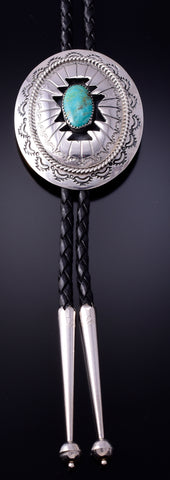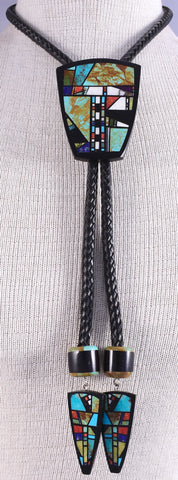Material: Sterling Silver, Leather (Bolo cord)
Dimensions: Main bolo cord is 1-5/8" x 2", bolo tips are 3/8" x 2-1/4", and bolo cord is 1/4" wide.
Weight (in grams): 46.4
Hallmark/Signature: TLd, Sterling
This piece is Hopi handmade overlay jewelry. Hopi is an indigenous tribe that is located in Arizona. They are known for their excellent overlay jewelry. The overlay process is where the design is cut out of a sheet of silver and soldered to another sheet, leaving a deep recessed area, which is later antiqued and darkened to bring out the beauty of the design.
The bolo tie, also known as a bola tie, is a unique necktie typically consisting of a piece of cord or braided leather with decorative metal tips, secured with an ornamental clasp or slide. Its origins can be traced back to the late 1940s and early 1950s in the American Southwest, particularly in the states of Arizona and New Mexico.
Its exact origins are somewhat debated, but it is widely believed that the bolo tie emerged from the Western cowboy culture, combining elements of Native American jewelry and Hispanic vaquero attire.
Initially worn by cowboys and ranchers as a practical and stylish alternative to traditional neckties, the bolo tie gradually gained popularity beyond the Western United States. It became associated with Southwestern and Western fashion and was adopted by politicians, entertainers, and other public figures as a symbol of regional pride and individuality.
In the 1970s and 1980s, the bolo tie experienced a surge in popularity, with prominent celebrities like Elvis Presley and Ralph Lauren incorporating it into their fashion statements. It also became a staple accessory in Western-themed events and rodeos.
Today, the bolo tie remains a distinctive symbol of Western and Southwestern style, often worn on special occasions or as a statement piece. Its versatility and unique aesthetic have made it a cherished part of American fashion history.




